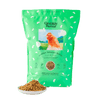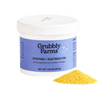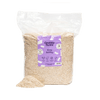Eggs are more than just tasty food that your backyard flock provides for your table. They can act as a ‘report card’ from your flock. Observing the appearance and quality of a chicken’s egg (both the external shell and the internal contents) can provide valuable clues about the hen’s health and well-being. While egg appearance and quality aren't a definitive diagnosis, they are a key part of monitoring flock health. From evaluating eggshell abnormalities to inspecting the egg yolk and albumen, learn how to judge the quality of an egg and what it may be telling you about your flock’s health!
The Basics: How to Judge Your Chicken's Health by Their Eggs
Egg formation is a complex biological process that requires specific nutrients. Hens will lay eggs under healthy conditions. Since creating an egg requires energy and nutrition, there is a fundamental connection between a hen’s internal health and the egg she lays. A hen’s internal health is often dependent on her diet, genetics, stress, and environmental factors.
When a hen is not getting the nutrition she needs, the results are sometimes reflected in the quality of the eggs she lays. Likewise, when factors such as stress, disease, or injury are affecting a hen, her eggs (or lack of eggs) can be an indicator of the ailment she is dealing with.
There are two main ways to judge an egg. You can look at the egg’s external appearance, observing its shape and the quality of the eggshell. Then you can crack open the egg and judge the internal contents, namely the egg yolk and albumen (egg white).
Judging Egg Shells: What to Look For
The eggshell is the first detail you will notice when examining an egg. Any changes to the eggshell will be the most noticeable since you can observe them without having to crack open the egg. A normal eggshell will be smooth, clean, uniformly colored, and feel firm. A properly formed eggshell should be able to support up to 10 pounds of even pressure.
A normal eggshell will also have a distinct shape. The egg should be slightly oblong in shape and have one end that is slightly pointy with the other end being more rounded. Slight variances in eggshell shape are normal and can be dependent on a hen’s breed. Some hens will lay eggs that are more rounded while other hens may lay eggs that are longer and oval-shaped.
The quality of the eggshell is important, both for protecting the egg and as an indicator of the hen’s health. The eggshell contains the contents of an egg and protects the contents from pathogens. It can also indicate the calcium absorption and nutrient metabolism of a hen. Eggshell quality is especially important if you plan on selling eggs or hatching the eggs.
There are several factors that can influence the quality of an eggshell:
- diet
- age of hen
- breed
- stress levels
- disease
Dietary elements such as calcium, phosphorus, and vitamin D are necessary for a strong eggshell to be created. A hen’s age and breed can influence her ability to metabolize those nutrients and use them for eggshell formation. Additionally, stress and disease can inhibit the proper formation of a strong eggshell.

Judging Egg Yolks & Whites: Color and Consistency
Observing an egg’s internal contents requires that you crack open the egg. The internal contents of an egg are composed of various parts, but the most noticeable parts will be the egg yolk and albumen (egg white).
A healthy egg yolk will have a vibrant color ranging from deep yellow to bright orange. It should also be firm (able to hold its shape) and rounded. The color of the egg yolk is primarily determined by a hen’s diet. Pigments, such as xanthophylls, are responsible for the color of the yolk as well as the color of a hen’s skin in some chicken breeds. These pigments are provided by certain foods like green plants, marigolds, and corn.
Lighter colored egg yolks usually mean there are less xanthophylls in a hen’s diet and are not necessarily an indicator of poor health. However, the absorption of xanthophylls from a hen’s diet can be influenced by the hen’s age or poor metabolism.
The firmness of the egg yolk is an indicator of an egg’s freshness. A weak, flat yolk is characteristic of an old egg. In some cases, a weak yolk can also indicate a health issue impacting nutrient deposition.
Now for the albumen. Healthy egg whites should have two layers. A thick, slightly cloudy layer that surrounds the egg yolk and a thinner, clearer layer that then spreads out from the thicker egg white. When both layers of the albumen appear thin that usually indicates that the egg is old. However, thin egg whites can also be a result of a hen’s age.
Common Chicken Egg Abnormalities and What They Mean
Egg abnormalities can occur both externally and internally. External abnormalities often influence the shape of the eggshell and can affect the eggshell quality, thickness, and color. Internal abnormalities influence the quality of the egg yolk and albumen and are usually only observed once the egg is cracked open.
Egg abnormalities can occur for various reasons, some of which are completely harmless. The occasional occurrence of an abnormal egg is common when young hens are just starting to lay or when older hens are slowing down in egg production. A hen may also lay a random abnormal egg if her reproductive system experiences a glitch.
However, abnormal eggs can also indicate health issues, including:
- stress
- nutritional deficiency
- underlying health problems
- chemicals/drugs
- respiratory diseases
- reproductive injury/infection
Shell Abnormalities: Textures, Bumps, and Spots
The formation of an eggshell starts in the oviduct, also called the shell gland. The oviduct is one of the last parts of a hen’s reproductive system. It is responsible for creating layers of calcium around the egg yolk and albumen, forming the eggshell. Issues during the formation of the eggshell manifest themselves on the shell’s surface, resulting in eggshell abnormalities like uneven textures, bumps, and spots.
Wrinkled Egg Shell
The surface of the eggshell has visible folds or ripples that can be seen and felt.
Wrinkled eggshells are often caused by stress, disease (like Infectious Bronchitis or a virus), or sometimes just an older hen nearing the end of her laying cycle. They can also be temporary eggshell glitches when young layers are just starting to lay. Eggs with wrinkled shells are usually perfectly safe to eat unless the shell is also thin and has cracked.
Mottled Eggs
Mottled eggshells will be most noticeable when an egg is candled. To candle an egg, hold the egg over a bright flashlight in a dark room to illuminate the interior of the egg. Mottled eggshells will have translucent spots that are visible when candled.
There are several factors that can cause a hen to lay an egg that has a mottled eggshell:
- high humidity that affects calcium utilization
- disease
- mycotoxins
- manganese deficiency
- lack of calcium
- stress
- overcrowding
Body-Checked Eggs
Body-checked eggs are eggs with a pronounced "belt" or ridge in the eggshell. They can also appear as a ‘healed’ crack in the eggshell.
A body-checked egg occurs when the eggshell is cracked or damaged in the oviduct and the damage is repaired by the oviduct before the egg is laid. This can occur if a hen experiences an injury to her abdomen or if she is roughly handled. It can also occur with older hens as their eggshells are generally thinner anyways and can more easily crack in the oviduct.
Bumps on Egg Shell / Calcium Deposits
Small bumps, rough patches, or raised white/brown spots on the eggshell surface are small abnormalities that affect the appearance of an egg. These brown/white spots are typically excess calcium/pigment deposits. They can cover the entire eggshell or just appear in small clumps on the shell.
These bumps or patches usually indicate a temporary issue with the calcium deposition process in the shell gland. They can be due to excess calcium in the diet, stress, or minor irritations in the oviduct. Calcium deposits are generally harmless and can often be scraped off. However, bigger calcium deposits may be firmly attached to the shell and you may remove part of the shell if you try to scrape off the deposit.
Thin Shells
Thin eggshells will be noticeably fragile or easily broken.
Thin eggshells are a significant indicator of potential health issues. Common causes of thin eggshells include:
- dietary deficiency (calcium, Vitamin D, phosphorus)
- heat stress
- aging hens
- moldy feed
- diseases (specifically respiratory diseases)
Regular occurrences of thin shelled eggs will require an investigation into your flock’s diet and environment.
Soft-Shelled or Shell-less Eggs
A soft-shelled egg, or shell-less egg, is an egg that gets laid without an eggshell. The contents of the egg are only enclosed by the shell membranes. The egg will feel soft and kind of like a water balloon.
Soft-shelled eggs are more serious than thin shells. They can be due to severe nutritional deficiencies, severe stress, electrolyte imbalance, moldy feed, or certain diseases (egg drop syndrome, viruses) affecting the shell gland function. Repeated occurrences of soft-shelled eggs may require immediate attention to your flock’s diet and health. Very young hens who start laying before their reproductive system has fully developed may also lay shell-less eggs.
Fairy Eggs
Fairy eggs are very small eggs that look like mini eggs and are often round in shape. Most fairy eggs don’t contain an egg yolk, they only contain a little bit of albumen. Fairy eggs are also called wind eggs, witch eggs, fart eggs, or rooster eggs.
Fairy eggs are most commonly laid by young pullets who are just starting to lay as their reproductive system matures. They can occasionally be laid by older hens due to stress or reproductive glitches. Fairy eggs are harmless, but they do indicate an immature or slightly off-kilter system.
Shape Abnormalities
Now that you know about some eggshell abnormalities, let’s discuss some egg shape abnormalities. A normal egg is oblong in shape and has a slightly pointy end and a blunt, rounded end. Some hens will lay eggs that are more rounded. Abnormalities in egg shape can occur when the eggshell is being formed in the oviduct just prior to the egg being laid.
Corrugated Eggs
Corrugated eggs have a rough, corrugated or wavy surface. The shell may also feel fragile or thin.
When a hen’s oviduct, or shell gland, gets damaged it can often lead to corrugated eggs. The oviduct can either be temporarily damaged or permanently damaged. Infections, rough handling, and injuries can all damage a hen’s oviduct.
Corrugated eggs can also be a result of heat stress, saline water, poor nutrition, mycotoxins in the hen’s feed, or a copper deficiency.
Slab-sided Eggs
Slab-sided eggs are eggs that have a flattened side.
Slab-sided eggs result when two eggs make contact with each other in the oviduct. This can happen if two egg yolks ovulate within a short time of each other and the eggs are both present in the oviduct at the same time. Egg yolks may ovulate rapidly when a hen is under stress, if there are lighting changes in the environment, or from a disease.
Misshapen Eggs
Misshapen eggs are eggs that deviate from the normal oblong shape. Tube eggs and curly shells are two examples of misshapen eggs.
Misshapen eggs can be laid by young hens who have just started laying and their oviduct is still immature. Respiratory diseases, stress, and overcrowding (which causes stress) can all cause a hen to lay a misshapen egg as well.
Internal Abnormalities: Inside the Egg
Egg abnormalities are not just restricted to an egg’s external appearance. Abnormalities can also appear in the contents of an egg. Issues that occur when an egg yolk ovulates or when the albumen is being added can result in abnormalities when you crack open an egg.
Double Yolks
A double yolk egg contains two egg yolks enclosed in one eggshell. In rare cases, eggs have been reported to contain 3, 5, and even 9 yolks!
Double yolk eggs typically occur when a hen ovulates two yolks in rapid succession, and they travel down the oviduct together and are enclosed in one shell. They are most common in young layers whose laying cycles are still maturing. Hens who are bred for high egg production are also more likely to lay double yolk eggs. Double yolk eggs are generally harmless and are usually considered a novelty. Laying double yolk eggs can also be a hereditary trait in some strains of chicken breeds.
Meat Spots or Blood Spots
Meat spots are small flecks of tissue usually found suspended in the albumen. Blood spots are spots or streaks of blood that can be seen in the albumen or on the yolk surface.
Blood spots are caused when tiny blood vessels rupture during ovulation. Meat spots are usually tissue that has been shed from the oviduct wall. While visually unappealing, they are generally harmless and can be removed. Blood spots and meat spots indicate a minor issue during egg formation. They can be more common in certain breeds or individual hens. Meat spots can sometimes be seen floating in the albumen when an egg is candled. Eggs containing meat spots should not be incubated for hatching.
Cloudy Egg Whites
Cloudy egg whites are when the albumen appears cloudy or opaque rather than clear.
Cloudy egg whites indicate freshness! The cloudiness is due to dissolved carbon dioxide which dissipates over time. Clear egg whites mean the egg is older. Cloudy egg whites are harmless and can be consumed.
When to Be Concerned
It is not uncommon for egg abnormalities to occur occasionally in your backyard flock. Since the process of forming an egg is very intricate, any glitch in the system can result in an egg abnormality. Some factors that cause abnormal eggs will resolve themselves, such as weather-related stress or as young egg layers finish maturing.
However, abnormal eggs can also indicate a health issue in your flock. Here’s are some factors to consider when determining if abnormal eggs are a potential sign of a health issue that needs intervention:
- Persistent abnormalities in multiple eggs from the same hen.
- Multiple hens in the flock laying abnormal eggs simultaneously.
- Abnormalities (especially thin/soft shells) coupled with other signs of illness (lethargy, reduced appetite, changes in droppings, ruffled feathers, behavioral changes).
- Sudden drop in egg production along with abnormalities.
If you suspect that a hen is laying abnormal eggs due to a health issues, you should consult a veterinarian who is familiar with poultry. You may also be able to determine the health issues based on other symptoms that the hen is exhibiting and by examining her feces.

Improving Egg Quality Through Flock Health
There are many factors that can influence the quality of your flock’s eggs. You can help prevent abnormal eggs and improve egg quality by taking into consideration these factors that influence a hen’s ability to lay quality eggs:
- Nutritional factors
- Environmental factors
- Age-related factors
- Disease factors
- Management factors
Nutritional Factors
An egg contains all the essential nutrients needed to sustain life, with the exception of vitamin C. That is why a hen’s diet plays such an important role in the quality of the eggs she lays. Additionally, a hen needs lots of calcium in order to create strong eggshells. In order for a hen to use calcium from her diet, phosphorus and vitamin D3 also need to be present. These nutritional factors that can lead to an increased chance of abnormal eggs:
- calcium, phosphorus, and vitamin D3 deficiencies
- excess calcium or phosphorus
- manganese deficiency
- vitamin imbalances
- feed quality issues
Make sure your flock gets a complete feed and a balanced diet on a daily basis. Give your hens access to a free-choice calcium supplement so that they can consume additional calcium as needed. A vitamin supplement can also be helpful during times when your flock is stressed or recovering from a disease or parasites.
Environmental Factors
The quality of a hen’s eggs can be influenced by her environment. Environmental factors that influence egg quality include:
- heat stress & humidity
- overcrowding
- lighting changes
- predator attacks
These factors are harder to control, but there are ways you can minimize their effect on your flock. During the summer, take measures to prevent heat stress in your flock during hot weather. Make sure your chicken coop has enough space for the size of your flock and that your flock has access to a spacious enclosure. If you supply supplemental light during the winter, make sure you add the light gradually to prevent any sudden lighting changes.
Age-Related Factors
A hen’s age will play a role in the quality of her eggs. Young pullets who are just starting to lay are more likely to lay abnormal eggs. This is because their reproductive systems are just kicking into gear and may not be fully matured yet. Abnormal eggs laid by young hens will often resolve themselves as the hens continue to mature.
Older hens are also more likely to lay abnormal eggs as their reproductive systems start to slow down. Older hens may also have a compromised metabolism that doesn’t allow them to fully utilize the nutrients in their diet for making quality eggs. Eggs laid by older hens may have thinner shells, watery albumens, and pale yolks.
Disease Factors
Egg formation occurs under healthy conditions. However, sometimes a hen who is just starting to come down with a disease will lay an abnormal egg or two before she stops laying completely. Additionally, a hen who has a chronic disease may still continue to lay, but her eggs may be abnormal or she may not lay as frequently. Here are some diseases that commonly cause abnormal eggs:
- Infectious bronchitis
- Newcastle disease
- Avian influenza
- Egg drop syndrome
- Viral infections
Management Factors
Flock management can influence the quality of a hen’s eggs. If a hen is not getting the care she needs, the results may show up in the form of abnormal eggs. Here are some management factors that influence egg quality:
- stress from handling
- poor coop conditions
- inadequate nesting boxes
- water quality issues
- feed contamination
Make sure your chicken coop is properly ventilated and that ammonia does not build up in the coop. Additionally, the coop should have plenty of nesting boxes that are padded with soft litter for hens to nest in. You should make sure that the water you give your flock is not contaminated and does not contain excess minerals. Keep your flock’s feed stored in a cool, dry place to prevent it from molding. Buy quality feed and keep it stored in a rodent-proof container to prevent contaminates from ruining your flock’s feed. These management practices can help keep your flock healthy and productive!
Conclusion
Observing your flock’s eggs is a useful, accessible tool for monitoring flock health. When you notice an egg abnormality, you can usually decipher if it means something serious or if it is just a minor glitch. Temporary or occasional abnormalities are common and are usually not a cause for alarm. However, abnormalities that persist can indicate more serious health concerns. Be observant and know your flock's "normal eggs” so you can seek professional advice when indicators point to potential health issues. Raising a happy, healthy backyard flock is rewarding when you get to collect a basketful of beautiful fresh eggs!








